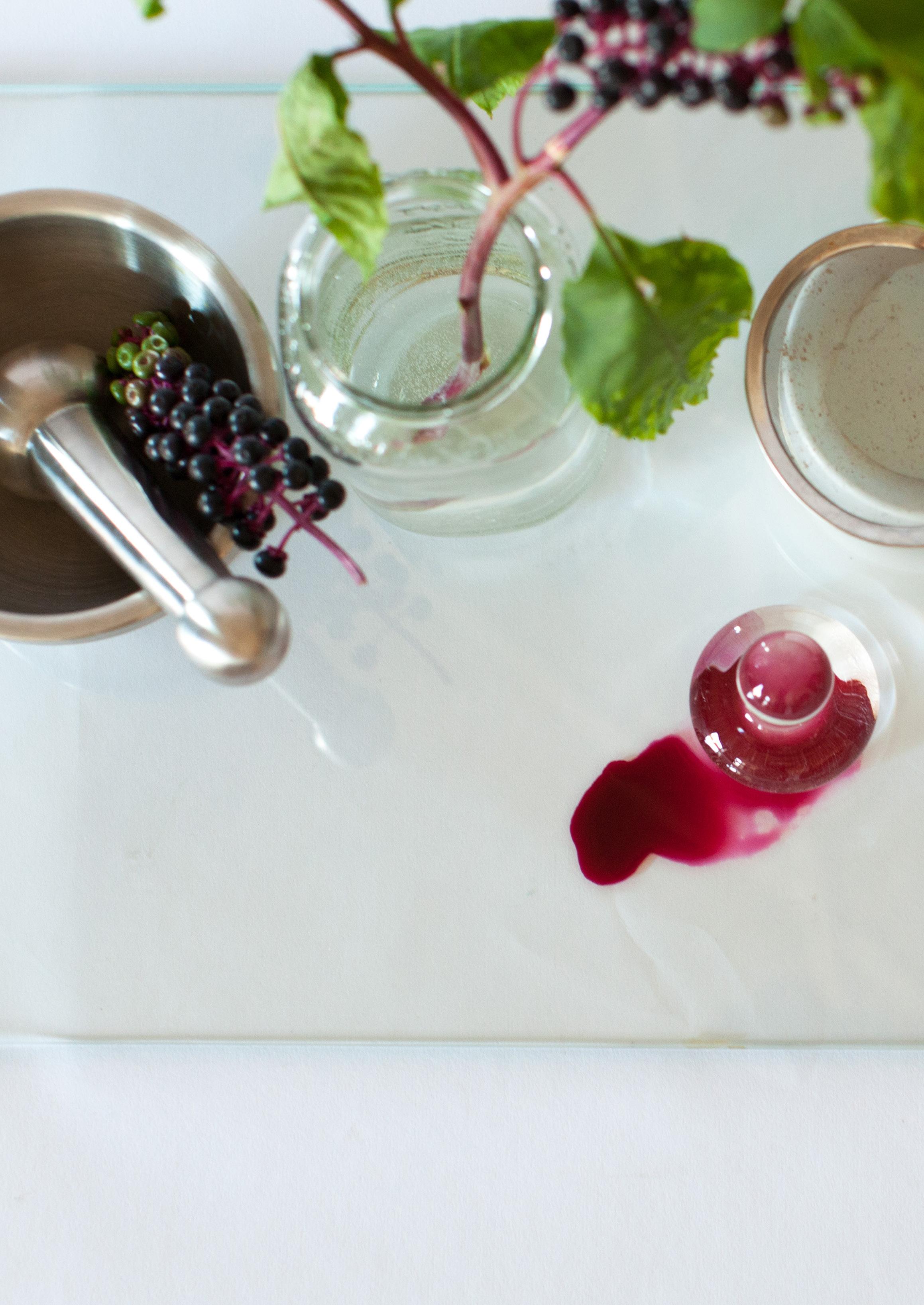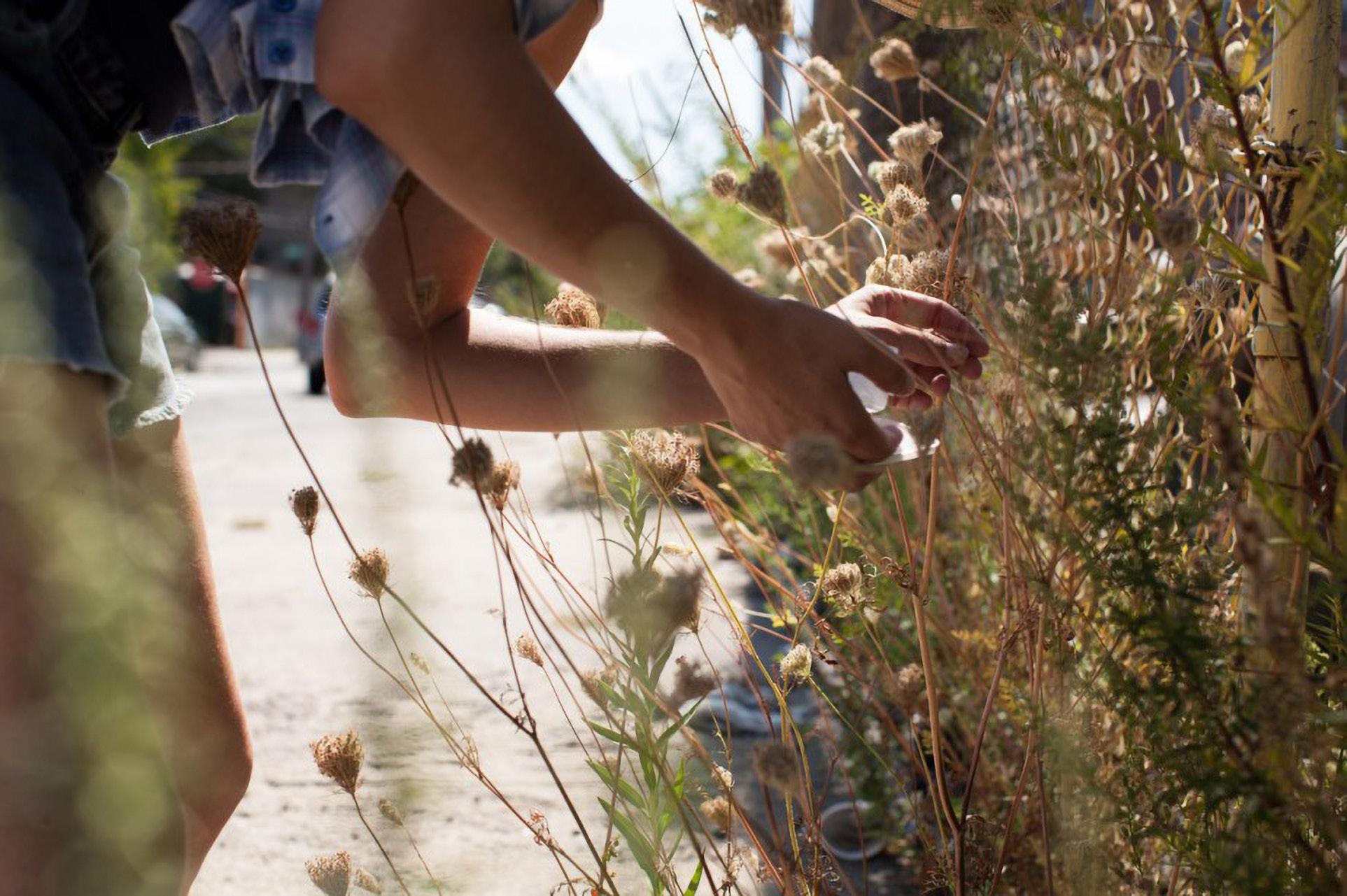
5 minute read
Feral & Invasive Pigments
How Ellie Irons Forages Her Colour Palette From The Urban Botanical Environment
Words & Photography by Ellie Irons
On Iron’s creative process:
Public fieldwork takes many forms, from foraging for pigment plants in street verges, to disrupting lawn monocultures with field ecology experiments. At stake in each of these endeavours is the remediation of reciprocal relationships between plants, people, and the habitat we’ve built together and continue to co-engineer. Spontaneous urban plants, co-evolved with humans over millennia, are the ideal companion lifeforms with whom to contemplate contentious issues around nativeness, biodiversity, ecological justice, and the future of multispecies thriving in the face of a sixth mass extinction event. Multisensorial work with spontaneous urban plants can provide an alternative pathway into environmental consciousness. This is a pathway that leads not a yearning nostalgia for pure nature, but rather to the realization that humans are part of a biocultural mesh, that, while unravelling in alarming ways, is also patching itself back together in delightful and surprising turns. I come from a background in painting and drawing, and while I continue to carry out studio-based work, much of what I make in this context has collaborative, participatory, and fieldwork-based roots.
When it comes to my Feral and Invasive Pigments project, I make paintings from this paint about the biological and cultural histories of the plants I work with and, I teach others how to do the same through walks and workshops. I’m interested in the performative nature of this practice. When I’m out in the field collecting pieces of weedy plants, passersby see me attending to the landscape, and are often curious about what I’m doing. Just this act of paying attention to something that is often overlooked is in a way re-valuing it, and asking others to consider doing the same.
Leading tours and workshops are a way for me to share my process with others. This has proven to be a powerful way to connect with urban ecology and build solidarity with the plants we live among. Searching for, collecting and processing plant parts on an intimate scale can be revelatory for those who have overlooked such organisms before, and deeply pleasurable for those who already appreciate them. Finally, I create field guides, publications, instructional videos and handbooks to help others carry on the practice when I’m not there to facilitate.

On foraging:
I think of foraging kind of like gleaning, but with some caveats. Gleaning being collecting and finding a use for overlooked, undervalued leftovers—usually perceived to be of no economic value—from human-ecological-biological-systems, like agriculture, manufacturing. These could be living things, but could also be non-living, like aluminium cans. With foraging, I tend to think of the materials being collected as living, and in some cases as goods that are of great value but are hard to find, or take too much effort to collect for most folks to be interested in doing it (like morel mushrooms, for instance). These valuable goods can be at risk of over-harvesting, which is where I see one caveat with foraging versus gleaning. The forager collecting from a living system, be it a city park or so-called wild forest, needs to be sensitive to the burden (or benefit) their foraging imposes on the life form being foraged.
Living things that have evolved in tandem with humans for millennia may be well adapted to being foraged regularly and sustainably (Robin Wall Kimmerer’s example of sweetgrass thriving best when regularly foraged by native peoples in the Northeastern US is an example) but others may be at risk of being over-foraged by large populations of humans, each one of whom might take just a little, but overharvest even so. With my personal foraging practice, I mostly forage what other folks think of as weeds, that grow wild and rapidly in response to human disturbance in cities and other human-impacted landscapes. Many of these plants respond well to disturbance or interruption from humans, so while it might appear that I’m controlling their populations by harvesting them, I don’t really think that’s the case, and that’s not what I’m trying to do anyhow. I collect for pleasure and to introduce others to the pleasure of being out in the landscape and connecting with living beings we often overlook.

I tend to forage mostly in marginal landscapes that are heavily impacted by human activity, like brownfields, superfund sites, sidewalk cracks, and other less maintained urban infrastructure. Foraging in these landscapes is a way of connecting with nature that often gets overlooked, but is very lively and full of ecological flows and biodiversity and abundance. Helping others learn to forage in these environments can help break down problematic notions about what nature should look like and what kinds of habitats are worth appreciating and protecting as we face the bottleneck of the sixth extinction.
For my paint-making process, my interest lies in breaking down notions of what is natural and what kinds of materials are organic. It makes me feel connected to my habitat, sensorially grounded, to know where my materials come from, and to have a hands-on role in collecting them, but I also collect bits of decaying plastic alongside collecting plant pigments, and the plants I collect from are often spurned as exotic, introduced and invasive so not considered natural by many.

On Invasive and Feral Pigments
Started in 2013, the work is a fieldwork and studio-based project that involves making watercolour paint from the leaves, petals, and berries of spontaneous plants growing in urban areas or places otherwise impacted by human activity. As a means of reducing plant blindness, revealing multispecies entanglements, and emphasizing the migration and proliferation of certain plants alongside humans, this hands-on approach to engaging local ecosystems is flexible across regions and habitats, but also intensely site-specific. I’ve created palettes in cities from Brooklyn to Taipei, and at a remote biological laboratory in the Rocky Mountains.
Feral and Invasive Pigments is a multilayered project, involving public fieldwork, archival research, local and global products, and an artisanal approach to the production of an industrialized product, artist paint. When I make these paints I mix the globally traded commodity gum arabic with locally harvested plant parts foraged from what, in New York City, I consider the shrinking commons. I use this hybrid mixture to make maps and plant portraits detailing species’ points of origin and spread through contact with humans, alongside pigment diagrams and charts that demonstrate connections, both metaphorical and physical, between plants, pigments and human-designed habitats.
THEEARTISSUE










